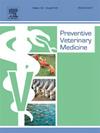Mapping risks: A value chain approach to brucellosis introduction in Zhijiang's Cattle Population, China
IF 2.2
2区 农林科学
Q1 VETERINARY SCIENCES
引用次数: 0
Abstract
Brucellosis, a zoonotic disease primarily transmitted through livestock, poses significant health and economic challenges globally. Its increasing incidence in China highlights critical gaps in current control measures, particularly in regions with high livestock movement, where domestic ruminants trade networks elevate the risk of disease transmission. Traditional value chain analyses often provide descriptive mappings of these networks but lack quantitative methods to assess specific risk levels. This study integrates value chain with quantitative risk assessment using Monte Carlo simulations to evaluate the risk of brucellosis introduction via cattle imports in Zhijiang. We comprehensively mapped the local cattle value chain, identifying key stakeholders, risk nodes, and critical pathways of infection. Utilizing a stochastic scenario tree model based on local data, we estimated the likelihood of infected cattle entering the region, revealing that unregulated brokers and inadequate quarantine measures significantly contribute to the risk. Our sensitivity analysis confirmed vulnerabilities in existing biosecurity protocols, emphasizing the need for enhanced quarantine measures and reliable testing at high-risk points in cattle trade. By combining value chain insights with quantitative analysis, this study effectively identifies critical vulnerabilities within livestock networks. Our findings lay the groundwork for developing targeted brucellosis prevention strategies in Zhijiang, underscoring the urgent need for strengthened biosecurity and risk management practices.
绘制风险图:中国枝江牛种群布鲁氏菌病引入的价值链方法
布鲁氏菌病是一种主要通过牲畜传播的人畜共患疾病,对全球健康和经济构成重大挑战。该疾病在中国的发病率不断上升,凸显了当前控制措施的严重差距,特别是在牲畜流动频繁的地区,在这些地区,国内反刍动物贸易网络提高了疾病传播的风险。传统的价值链分析通常提供这些网络的描述性映射,但缺乏定量方法来评估具体的风险水平。本研究将价值链与定量风险评估相结合,采用蒙特卡罗模拟方法对枝江市进口牛引入布鲁氏菌病的风险进行了评估。我们全面绘制了当地牛价值链,确定了关键利益相关者、风险节点和关键感染途径。利用基于当地数据的随机情景树模型,我们估计了感染牛进入该地区的可能性,揭示了不受监管的经纪人和不充分的检疫措施是导致风险的重要因素。我们的敏感性分析证实了现有生物安全协议中的漏洞,强调需要在牛交易的高风险点加强检疫措施和可靠检测。通过将价值链洞察与定量分析相结合,本研究有效地确定了畜牧业网络中的关键脆弱性。我们的研究结果为芷江制定有针对性的布鲁氏菌病预防战略奠定了基础,强调了加强生物安全和风险管理实践的迫切需要。
本文章由计算机程序翻译,如有差异,请以英文原文为准。
求助全文
约1分钟内获得全文
求助全文
来源期刊

Preventive veterinary medicine
农林科学-兽医学
CiteScore
5.60
自引率
7.70%
发文量
184
审稿时长
3 months
期刊介绍:
Preventive Veterinary Medicine is one of the leading international resources for scientific reports on animal health programs and preventive veterinary medicine. The journal follows the guidelines for standardizing and strengthening the reporting of biomedical research which are available from the CONSORT, MOOSE, PRISMA, REFLECT, STARD, and STROBE statements. The journal focuses on:
Epidemiology of health events relevant to domestic and wild animals;
Economic impacts of epidemic and endemic animal and zoonotic diseases;
Latest methods and approaches in veterinary epidemiology;
Disease and infection control or eradication measures;
The "One Health" concept and the relationships between veterinary medicine, human health, animal-production systems, and the environment;
Development of new techniques in surveillance systems and diagnosis;
Evaluation and control of diseases in animal populations.
 求助内容:
求助内容: 应助结果提醒方式:
应助结果提醒方式:


